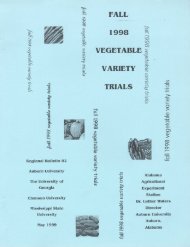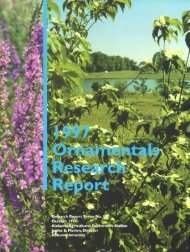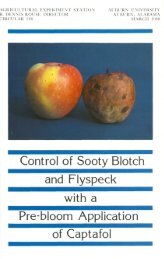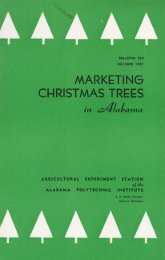Fall - Auburn University Repository
Fall - Auburn University Repository
Fall - Auburn University Repository
You also want an ePaper? Increase the reach of your titles
YUMPU automatically turns print PDFs into web optimized ePapers that Google loves.
LEGUME INOCULATION-<br />
Product of Early Research<br />
INOCULATION and its importance to successful<br />
production of certain leguminous<br />
crops is common knowledge among Alabama<br />
farmers today.<br />
But few know that some of the first<br />
research in this country with inoculum<br />
or "germ fertilizer" was done at the <strong>Auburn</strong><br />
Agricultural Experiment Station<br />
more than three score years ago. Its results<br />
provided the answer to the mystery<br />
why certain leguminous plants produce<br />
poor yields on soils on which no legume<br />
had been recently grown. Legumes used<br />
in this early work included vetch, crimson<br />
clover, lupine, lespedeza, alfalfa,<br />
Canada field peas, and cowpeas.<br />
"The subject of maintaining fertility<br />
of the land very closely concerns every<br />
tiller of the soil, whether cotton planter,<br />
tobacco grower, grain farmer, livestock<br />
breeder, or horticulturist."<br />
The foregoing paragraph is the introduction<br />
to <strong>Auburn</strong> Station Bulletin<br />
No. 87, published in the summer of<br />
1897, reporting early research on soil<br />
inoculation for leguminous plants. The<br />
words are those of the late Prof. J. F.<br />
Duggar, who joined the <strong>Auburn</strong> staff a<br />
year earlier and whose later work made<br />
it possible to condition the soil for growing<br />
certain legumes to supply much<br />
needed nitrogen. He is credited with<br />
having been one of the first researchers<br />
in this country to have experimented with<br />
"artificial cultures" for growing clovers<br />
and other legumes.<br />
In the light of discoveries in Europe,<br />
Professor Duggar determined that some<br />
Alabama soils had to be inoculated by<br />
the necessary germ-life to grow legumes.<br />
First with a homemade preparation and<br />
then with a patented concentrate from<br />
Germany, he launched a long-range campaign<br />
to get Alabama farmers to inoculate<br />
their fields so soil improving legumes<br />
could be grown.<br />
In Station Bulletin 87, Professor Duggar<br />
in the main presented results from<br />
greenhouse pot experiments in which he<br />
compared growth of inoculated and uninoculated<br />
legumes. His yield increases<br />
were dramatic.<br />
KENNETH B. ROY, Editor<br />
LILLIAN FOSCUE, Graduate Assistant<br />
Professor Duggar emphasized the<br />
value of inoculation in Bulletin No. 96,<br />
published August 1898. Reporting on<br />
experiments with crimson clover and<br />
hairy vetch, he wrote, "clover, vetch,<br />
and similar leguminous plants are able<br />
to draw much of their nitrogen from the<br />
air when enlargements called tubercules<br />
or nodules are found on their roots. They<br />
are unable to do this, or to store up fertility,<br />
when tubercules are absent.<br />
This is the second article of a series<br />
on <strong>Auburn</strong> <strong>University</strong> and its Agricultural<br />
Experiment Station Systemits<br />
founding and its contributions<br />
down through the years to the progress<br />
of Alabama's agriculture. The<br />
series is being published in conjunction<br />
with <strong>Auburn</strong>'s Centennial Celebration.-Editor<br />
"In order for tubercules to develop,<br />
specific germs of bacteria must come in<br />
contact with the young rootlets. In the<br />
regions where the clovers, vetch, alfalfa,<br />
etc. are extensively grown, these germs<br />
become generally distributed in the soil<br />
of the entire region. In a number of localities<br />
in Alabama, where these legumes<br />
are not grown to any great extent, these<br />
germs are absent from some soils or<br />
present in insufficient numbers."<br />
-~U L V ~CIIULII~ UI LU IW ~VIILIIUULIVIIU<br />
FREE Bulletin or Report of Progress<br />
AGRICULTURAL EXPERIMENT STATION<br />
AUBURN UNIVERSITY<br />
E. V. Smith, Director<br />
<strong>Auburn</strong>, Alabama<br />
Permit No. 1132-8/61-IOM<br />
The researcher reported good results<br />
from two methods of inoculation: (1)<br />
scattering on a field some of the germladen<br />
soil from a field where the legumes<br />
have borne tubercules, and (2)<br />
use of a prepared material called Nitragin,<br />
"a concentrated germ fertilizer containing<br />
myriads of germs which are able<br />
to cause the growth of tubercules on the<br />
roots of certain leguminous or soil improving<br />
plants."<br />
Large yield increases in field experiments<br />
resulted from the use of an inoculum,<br />
as reported in Bulletin 96. Hairy<br />
vetch inoculated with vetch Nitragin<br />
produced hay at the rate of 3,270 lb.<br />
per acre, as compared with 564 lb. without<br />
inoculation. Using soil from an old<br />
vetch field as inoculum increased yield<br />
by 2,308 lb. of hay over an uninoculated<br />
companion plot. Crimson clover yield increase<br />
from inoculation was reported to<br />
be 3,296 lb.<br />
Long lasting effect of inoculation was<br />
also learned. It was reported that "'a field<br />
once inoculated, whether naturally or<br />
artificially, remains inoculated for years."<br />
Other information included the fact that,<br />
in general, each genus of leguminous<br />
plant has its own specific or adapted<br />
germ.<br />
Successful growth of legumes in Alabama<br />
was a major breakthrough that has<br />
been invaluable to farmers of the State.<br />
Use of these crops as soil improving and<br />
forage plants came about as a direct result<br />
of the early, basic research.<br />
Research on legume production has<br />
not stopped. Work has continued through<br />
the years on variety testing and development,<br />
time of planting, seedbed preparation,<br />
fertility requirements, and on<br />
other cultural practices. This ongoing research<br />
continues to provide information<br />
that enables farmers to do a better job<br />
of legume production and utilization.<br />
PENALTY FOR PRIVATE USE TO AVOID<br />
PAYMENT OF POSTAGE, $300
















